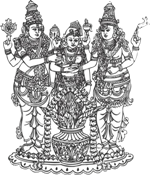History

Even until five decades ago, washed and bleached white fabric used to flutter on the banks of the Vaigai river in the enchanting temple town of Madurai, ready to be distributed for marking of designs and tying.
Thus begins the story of the Sungudi whose beauty has inspired poets to compare it to twinkling stars on the vast expanse of a clear sky. This has prompted some to assert that Sungudi patterns are inspired by heavenly constellations.
Sungudi:
Reminiscing the Royalty, Romancing the Glitterati
 What is sungudi? A craftsperson ties a thread around a tiny portion of fabric, knots it tightly and repeats. Once the fabric is dyed and the knots untied, the previously-knotted areas will transform into tiny dots. The sungudi craft has an interesting history, comprising its journey from Western and Central India to the city of Madurai in South India which has become synonymous with the sungudi saris. This textile craft was brought by a community of weavers who migrated from Saurashtra and finally settled in the temple city of Madurai during the Nayak dynasty around the 16th century. These weavers were skilled craftsmen. Their women folk specialized in the tying work while the men focused on the dyeing. The Saurashtran word 'sungudi' is derived from the sanskrit word 'sunnam' meaning 'round'. Thus, sungudi literally meant ringed dots, which are spread throughout the fabric of the saree and form a distinct and special feature. This tie and dye craft was traditionally produced in fine handloom cloth and often has a zari border.
What is sungudi? A craftsperson ties a thread around a tiny portion of fabric, knots it tightly and repeats. Once the fabric is dyed and the knots untied, the previously-knotted areas will transform into tiny dots. The sungudi craft has an interesting history, comprising its journey from Western and Central India to the city of Madurai in South India which has become synonymous with the sungudi saris. This textile craft was brought by a community of weavers who migrated from Saurashtra and finally settled in the temple city of Madurai during the Nayak dynasty around the 16th century. These weavers were skilled craftsmen. Their women folk specialized in the tying work while the men focused on the dyeing. The Saurashtran word 'sungudi' is derived from the sanskrit word 'sunnam' meaning 'round'. Thus, sungudi literally meant ringed dots, which are spread throughout the fabric of the saree and form a distinct and special feature. This tie and dye craft was traditionally produced in fine handloom cloth and often has a zari border.
 Over a period of time, this textile craft lost its lustre. In the face of modernization, the royal provenance of the sungudi saris was forgotten. Furthermore, with the advent of industrialization, authentic handmade sungudi textiles were replaced with cheaper, machine-made, inauthentic replications of the sungudi saris. This led to the bleak predicament of the sungudi, where it was driven to the state of a languishing craft.
Over a period of time, this textile craft lost its lustre. In the face of modernization, the royal provenance of the sungudi saris was forgotten. Furthermore, with the advent of industrialization, authentic handmade sungudi textiles were replaced with cheaper, machine-made, inauthentic replications of the sungudi saris. This led to the bleak predicament of the sungudi, where it was driven to the state of a languishing craft.
However, even as you read this passage, the history of the sungudi craft is being rewritten due to the project "Reviving Sungudi", which seeks to preserve the cultural heritage of India by rejuvenating and revitalizing this ancient craft. This project strives to remind and restore the revered status of the sungudi craft.
 The untying of every knot reveals the classic elegance of the dotted designs and restrained beauty of surface ornamentation produced by the sungudi craft. It is an amalgamation of an ancient technique and skill with modern designs and styles. During the pre-colonial era, the sungudi has adorned queens and was celebrated at the palaces of Tamil kings. During contemporary times its ancient royal provenance has been transformed into trendy and glamorous designer merchandise that caresses the vibrant youth and the fashion glitterati and socialites.
The untying of every knot reveals the classic elegance of the dotted designs and restrained beauty of surface ornamentation produced by the sungudi craft. It is an amalgamation of an ancient technique and skill with modern designs and styles. During the pre-colonial era, the sungudi has adorned queens and was celebrated at the palaces of Tamil kings. During contemporary times its ancient royal provenance has been transformed into trendy and glamorous designer merchandise that caresses the vibrant youth and the fashion glitterati and socialites.
The unravelling of each sungudi textile thus opens a window to the Tamil heritage. Sungudi craft is therefore, a repository of the ancient handcrafting skill set, a signifier of culture and a marker of regional identity.
--Dr. Kala Shreen, Cultural Anthropologist
Reference:Department of Handlooms and Textiles (2009), Registration of Geographical Indication, Government of Tamilnadu.
